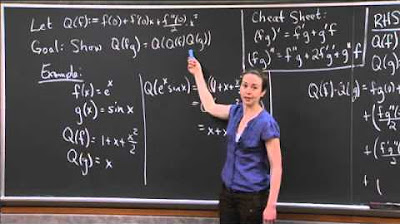Using the Trapezoid and Simpson's rules | MIT 18.01SC Single Variable Calculus, Fall 2010
TLDRThis video script from a recitation session focuses on teaching students how to estimate the integral of sin(x) from 0 to π using two numerical methods: the trapezoid rule and Simpson's rule, both with n equal to 4. The professor provides a step-by-step guide, including a table of x and y values for sin(x), and demonstrates the application of both rules. The explanation includes visual representations of the approximations on the graph and emphasizes the importance of creating a table of values for simplifying the process. The goal is to compare these approximations with the actual integral to understand the effectiveness of these numerical methods.
Takeaways
- 📚 The video is a recitation session focused on practicing approximation techniques for integrals.
- 📉 The integral to be estimated is from 0 to pi of sin x dx using two specific methods: the trapezoid rule and Simpson's rule.
- 🔢 The approximation is to be done for n equal to 4, which means the interval from 0 to pi is divided into four sub-intervals.
- 📈 A sketch of y equals sin x is provided to visualize the function over the interval from 0 to pi.
- 📝 The professor has prepared a table with x-values and corresponding y-values (sin x) to facilitate the calculations.
- 🔑 The trapezoid rule formula involves averaging the first and last y-values and summing all y-values with coefficients.
- 📐 The trapezoid rule gives an approximation by connecting consecutive y-values and calculating the area of trapezoids formed.
- 📉 Simpson's rule is applicable because n is an even number, and it uses a specific set of coefficients for the y-values.
- 🔍 Simpson's rule formula includes a factor of delta x over 3 and alternating coefficients of 1, 4, 2, 4, 1 for the y-values.
- 📊 The actual integral value should be evaluated to compare the approximations made by the trapezoid and Simpson's rules.
- 💡 Creating a table of values at the beginning simplifies the process of plugging in values into the formulas for both approximation methods.
Q & A
What is the main topic of the video?
-The main topic of the video is to practice approximation techniques, specifically the trapezoid rule and Simpson's rule, to estimate the integral from 0 to pi of sin x dx.
What are the two approximation methods discussed in the video?
-The two approximation methods discussed are the trapezoid rule and Simpson's rule.
What is the integral being approximated in the video?
-The integral being approximated is the integral from 0 to pi of sin x dx.
How many sub-intervals are used for the approximations in the video?
-Four sub-intervals are used for the approximations, as indicated by n equal to 4.
What is the length of each sub-interval when n is 4?
-The length of each sub-interval is pi divided by 4.
What is the formula for the trapezoid rule as used in the video?
-The formula for the trapezoid rule used in the video is delta x times (y_0/2 + y_1 + y_2 + ... + y_4/2).
How does the trapezoid rule approximate the area under the curve?
-The trapezoid rule approximates the area by connecting consecutive y-values with straight lines and calculating the area of each trapezoid formed.
What is Simpson's rule and why is it used in the video?
-Simpson's rule is a method for numerical integration that provides a more accurate approximation than the trapezoid rule. It is used in the video because n is an even number, which is a requirement for using Simpson's rule.
What are the coefficients used in Simpson's rule as shown in the video?
-The coefficients used in Simpson's rule in the video are 1 for y_0 and y_4, 4 for y_1 and y_3, and 2 for y_2.
What is the purpose of creating a table of x and y values at the beginning of the video?
-The purpose of creating a table of x and y values is to simplify the process of applying the approximation methods by having all necessary values readily available for reference.
How does the video suggest comparing the approximations to the actual integral?
-The video suggests evaluating the actual integral and comparing the results of the trapezoid rule and Simpson's rule approximations to see how well these numerical methods work.
Outlines
📚 Introduction to Approximation Techniques
The professor begins the recitation by welcoming students back and introducing the topic of approximation techniques for integrals. The focus is on estimating the integral of sin(x) from 0 to π using two methods: the trapezoid rule and Simpson's rule, both with n equal to 4. The professor provides a sketch of y = sin(x) over the interval and suggests that students work on the problem before showing the solution. The importance of understanding the approximation process is emphasized.
📈 Applying the Trapezoid Rule for Approximation
After a brief recap, the professor demonstrates the application of the trapezoid rule to approximate the integral. The rule is explained as averaging the values at the endpoints of each sub-interval. The formula involves coefficients of 1/2 for the first and last values and 1 for the rest. The professor constructs a table with x-values from 0 to π divided by 4 and their corresponding y-values for sin(x). Using these values, the trapezoid rule is applied to find an approximation of the integral, simplifying the expression to root 2, and noting the method's effectiveness in estimating the integral visually represented on the graph.
📉 Simpson's Rule for Integral Approximation
The professor then moves on to Simpson's rule, which is applicable since n is an even number. The rule's formula is detailed, with specific coefficients for each y-value based on their position in the interval. The professor calculates the approximation using the given coefficients and the previously determined y-values, resulting in an expression involving pi, 4 root 2, and 2. The comparison of this approximation with the trapezoid rule and the actual integral is suggested for further analysis. The importance of creating a table of values at the beginning to simplify the process is highlighted, and the professor concludes the demonstration of both approximation methods.
Mindmap
Keywords
💡Approximation Techniques
💡Trapezoid Rule
💡Simpson's Rule
💡Integral
💡Subintervals
💡Delta x (Δx)
💡Y-values
💡Numerical Methods
💡Sin(x)
💡Table of Values
Highlights
Introduction to the recitation video focusing on approximation techniques for integrals.
Use of the trapezoid rule and Simpson's rule for estimating the integral of sin(x) from 0 to π.
The requirement for n equal to 4 for both approximation methods.
Visual sketch of y = sin(x) between 0 and π to aid understanding.
Explanation of the trapezoid rule formula and its application.
Construction of a table with x-values and corresponding y-values for sin(x).
Subdivision of the interval [0, π] into four equal sub-intervals.
Calculation of the trapezoid rule with specific y-values for the given interval.
Graphical representation of the trapezoid rule's approximation on the graph.
Introduction to Simpson's rule and its conditions (n must be even).
Detailed explanation of Simpson's rule coefficients and their significance.
Application of Simpson's rule using the pre-calculated y-values.
Simplification of the Simpson's rule calculation to compare with the trapezoid rule.
Comparison of the approximations with the actual integral for accuracy assessment.
Importance of creating a table of values at the beginning for simplifying calculations.
Final summary of the approximation techniques and their practical use in estimating integrals.
Transcripts
Browse More Related Video

Lec 25 | MIT 18.01 Single Variable Calculus, Fall 2007

Calculus Chapter 5 Lecture 49 Numerical Integration II

Quadratic Approximation of a Product | MIT 18.01SC Single Variable Calculus, Fall 2010

Integration Practice II | MIT 18.01SC Single Variable Calculus, Fall 2010

Calculus AB Homework 6.2 Riemann and Trapezoidal Sums

What is Calculus? (Mathematics)
5.0 / 5 (0 votes)
Thanks for rating: